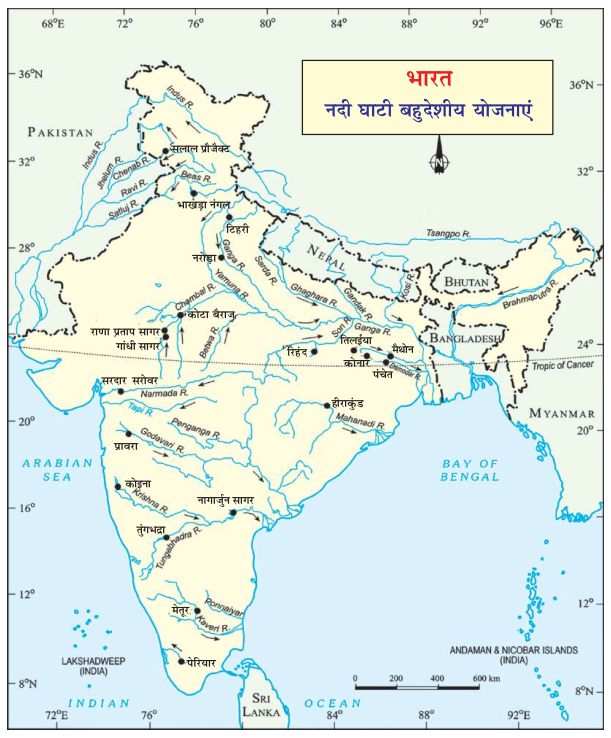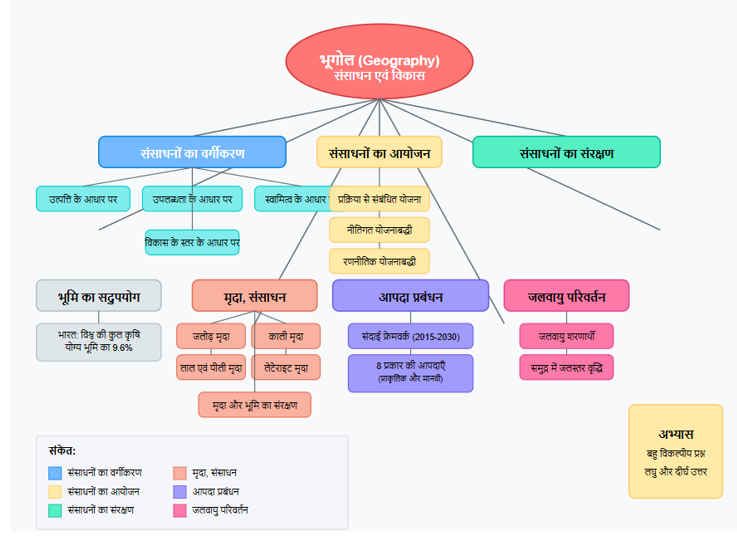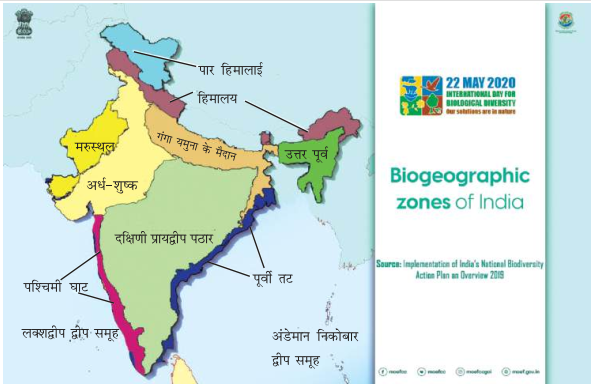1. Multiple-Choice Questions-
(i) Based on the following information, tell which areas are in crisis due to water scarcity and which are not-
Answer:
Areas in crisis due to water scarcity:
-
(b) Areas with high annual rainfall and high population: Because high population leads to excessive demand for water, which can cause water scarcity even with abundant rainfall.
-
(c) Areas with high annual rainfall but severely polluted water: Because even if water is available, it is not usable due to pollution, effectively leading to water scarcity.
-
(d) Areas with low annual rainfall and low population: Because low annual rainfall indicates a natural scarcity of water, and even a low population can face water stress in such regions.
Relatively not in crisis due to water scarcity:
-
(a) Areas with high annual rainfall: If the population is normal and the water is also pure, then the possibility of a water crisis in such areas is less.
(ii) Which statement is not applicable to multipurpose river projects?
(b) With multipurpose projects, rivers are controlled and floods are stopped. (This statement is not entirely applicable because sometimes sudden release of water from dams can also cause floods.)
(iii) India has ………. percent of the world’s renewable water resources.
(b) Four (4)
(iv) On earth ……percent water is saline and ……percent is fresh.
(a) 97 and 03 (Approximately 97% saline and 2.5% to 3% fresh)
(v) Which sector uses the most fresh water?
(c) Agriculture (Zaraiti)
(vi) When was Swachh Bharat Mission-Gramin launched?
(c) Year 2014
(vii) What is the full form of C.W.M.I.?
(a) Composite Water Management Index
(viii) Match the correct pairs:-
-
(i) Bhakra Dam – (d) Sutlej
-
(ii) Hirakud Dam – (a) Mahanadi
-
(iii) Indira Sagar Dam – (b) Narmada
-
(iv) Tehri Dam – (c) Bhagirathi
2. Answer the following questions in 30 words:-
(i) How does water become a renewable resource?
Answer: Water is a renewable resource because it is continuously replenished through the hydrological cycle. Water evaporates due to the sun’s heat, forms clouds, and returns to Earth as precipitation, refilling water sources.
(ii) What is the process of water scarcity and what is its main cause?
Answer: Water scarcity is a situation where the availability of freshwater is less than the demand. Its main causes are increasing population, excessive demand from agriculture and industrial expansion, mismanagement of water, and pollution.
(iii) What can be the advantages and disadvantages of multipurpose river projects?
Answer: Advantages of multipurpose projects include irrigation, hydroelectricity, flood control, and water supply. Disadvantages include displacement, ecological damage, seismicity, biodiversity loss, and inter-state disputes.
(iv) How is water the most important element on earth?
Answer: Water is the most important element on Earth because it is essential for the life of all living beings and plants, agriculture, industry, and the ecological balance of the Earth. Life is not possible without water.
(v) What are the meanings of ‘blue water’ and ‘green water’?
Answer: ‘Blue water’ refers to surface and groundwater sources like rivers, lakes, and aquifers. ‘Green water’ is rainwater stored in the soil and used by plants in evapotranspiration.
(vi) Write a note on the use of water in the agricultural sector?
Answer: The agricultural sector is the largest consumer of freshwater, most of which is used for irrigation. In India, groundwater is excessively exploited for agriculture, which can lead to a decline in the groundwater level.
(vii) What is a dam?
Answer: A dam is a barrier structure built to stop or control the flow of river water. A reservoir is formed behind it, the water of which is used for various purposes.
(viii) Share any three elements of water damming in ancient India?
Answer: Three key elements of water management in ancient India were: (1) dams made of stone and rubble, (2) construction of ponds and lakes for water storage, and (3) building strong embankments along rivers.
3. Answer the following questions in up to 250 words:-
(i) Can rainwater be managed in the semi-arid regions of Rajasthan?
Answer: Yes, in the semi-arid regions of Rajasthan, where annual rainfall is extremely low and erratic, rainwater management is not only possible but also imperative for the survival of its inhabitants and ecosystem. The geographical and climatic conditions of these regions have given rise to traditional water conservation techniques that remain relevant even today. The ‘Tanka’ system, where rainwater from rooftops is stored in underground tanks, is a significant source of drinking water, especially during the dry season. Similarly, structures like ‘Khadin’ and ‘Johad’ are excellent examples of community-level water conservation. In a ‘Khadin’, earthen bunds are constructed on sloping land to trap rainwater, which helps retain soil moisture, making it possible to grow rabi crops, and also recharges groundwater. ‘Johads’ are small ponds that collect rainwater and provide water for livestock and domestic use. The efforts of water conservationists like Dr. Rajendra Singh, through Tarun Bharat Sangh, have revived these traditional techniques, breathing life into dry rivers and making communities water self-sufficient. By integrating this traditional knowledge with modern technologies, such as GIS mapping for precise location selection and the use of advanced construction materials, rainwater management can be made more effective and sustainable, thereby improving the quality of life in these water-scarce regions.
(ii) How can traditional rainwater management be implemented in the present time?
Answer: Traditional rainwater management techniques can be successfully implemented in the present time, as these methods have not only stood the test of time but are also eco-friendly, cost-effective, and community-centric. Implementing them requires a multi-pronged approach. Firstly, traditional structures prevalent in different regions, such as ‘Kuhls’ in hilly areas, ‘Johads’ and ‘Khadins’ in Rajasthan, ‘Eris’ and ‘Ooranis’ in South India, and other ponds, step-wells (baolis), and tanks, need to be identified and revived. These can be strengthened and made more durable using modern engineering knowledge and materials, while retaining their original design principles. In urban areas, where water scarcity and waterlogging are both problems, mandating rainwater harvesting from rooftops of homes and buildings and channeling it through filters into recharge pits or underground tanks for groundwater recharge is an effective solution. This requires amendments in building by-laws and incentives for citizens. In rural areas, these traditional structures can be integrated with schemes like MGNREGA under watershed development programs, thereby creating employment along with water conservation. Community participation and valuing local knowledge are crucial, as the community builds, maintains, and manages these structures. Government policies, awareness campaigns, and technical guidance can play a significant role in making these efforts successful, ensuring water security and sustainable development.
(iii) What changes have multipurpose projects brought in the agricultural sector?
Answer: Multipurpose projects have brought about revolutionary, yet mixed, changes in India’s agricultural sector. Post-independence, the primary objective of these projects was to expand irrigation facilities, increase agricultural production, ensure food security, and boost the rural economy. The positive impacts included a vast expansion of the irrigated area, which freed farmers to some extent from the uncertainties of the monsoon and made it possible to grow more than one crop a year. This fueled the Green Revolution, leading to an unprecedented increase in the production of major food grains like wheat and rice, and moving India towards food self-sufficiency. The cultivation of cash crops like sugarcane and cotton also received a fillip, increasing the income of some farmers.
However, these widespread changes were accompanied by some serious negative consequences. In canal-irrigated command areas, excessive irrigation and inadequate drainage led to problems of waterlogging and soil salinity/alkalinity, rendering millions of hectares of fertile land barren. Unequal distribution of water often benefited large and influential farmers, while small and marginal farmers remained deprived, exacerbating socio-economic disparities. These projects encouraged water-intensive crops over traditional, less water-consuming ones, thereby increasing pressure on groundwater resources. Obstruction of the natural flow of rivers in many areas led to siltation in reservoirs and adversely affected fish breeding cycles and aquatic ecosystems. Inter-state water disputes have also increased due to these projects. Thus, while these projects have transformed agriculture, there is a continuous need for improvement in their management and planning for sustainable and equitable agricultural development.
(iv) What is rainwater harvesting? How can it be implemented?
Answer: Rainwater harvesting is the process of collecting and storing rainwater where it falls or nearby, using various techniques, to prevent it from running off wastefully and to conserve it for future use. Its main objectives are to recharge groundwater, reduce surface water runoff thereby controlling soil erosion and urban floods, and enhance local water availability to mitigate water scarcity.
It can be implemented in various ways, depending on local geographical conditions, rainfall patterns, and water needs:
-
Urban Areas: Rainwater falling on the rooftops of houses, schools, and other buildings is collected through pipes. This water can be filtered and stored in underground tanks for drinking or other domestic purposes, or it can be channeled into the groundwater through soak pits, trenches, or recharge wells.
-
Rural Areas: Small bunds (contour bunding) can be made in fields to retain rainwater within the field, which increases soil moisture. Structures like farm ponds, ‘Johads’, ‘Khadins’, and percolation tanks can be constructed to store large volumes of rainwater, which is useful for irrigation and livestock. Check dams or gully plugs can be built across small streams to slow down water flow, allowing more time for water to percolate and recharge groundwater.
-
Semi-hilly and Hilly Areas: Contour trenches and small earthen bunds can be constructed to trap rainwater, which aids in groundwater recharge and afforestation.
Community awareness and participation, government incentives, and technical guidance are crucial for the success of rainwater harvesting. It is a decentralized, cost-effective, and environmentally friendly way to ensure water security.
(v) What is the Seechewal model for water purification and how is water managed?
Answer: The Seechewal model for water purification is a low-cost, eco-friendly, and community-based natural water treatment system developed by Sant Balbir Singh Seechewal of Punjab. Its primary objective is to treat wastewater (sewage) from villages and towns using natural methods, making it reusable for irrigation and other purposes, thereby preventing polluted water from entering rivers and reducing pressure on freshwater resources.
Water management and purification in this model occur in several stages:
-
Collection and Preliminary Treatment: All wastewater from the village or town is collected at one point through pipelines. Here, solid waste like plastic, cloth, etc., is removed through screening.
-
Sedimentation: The water is then passed sequentially through a series of small ponds or wells. In the first pond, heavier particles and silt settle down due to gravity.
-
Oil and Grease Removal: In some designs, special ponds are used to separate oil and grease floating on the water surface.
-
Biological Treatment and Oxidation: The water is then retained in a large, shallow pond (oxidation pond) for a few days. Here, sunlight, air, and microorganisms (algae and bacteria) present in the water work together to decompose organic matter and purify the water. Algae produce oxygen, which helps bacteria break down organic waste.
-
Reuse: The water thus treated is then supplied to fields for irrigation.
Water management in this model means viewing wastewater as a resource, stopping it from flowing wastefully, treating it, and reusing it. This not only reduces water pollution but also curtails the over-extraction of groundwater, lowers agricultural costs, and improves rural sanitation. This model has been highly successful in the rejuvenation of the Kali Bein river and is being adopted in other places as well.
(vi) Discuss the NITI Aayog Report-2018 on the water crisis in India.
Answer: The ‘Composite Water Management Index’ (CWMI) report released by NITI Aayog in June 2018 presents a grim picture of India’s escalating water crisis and seeks to foster cooperative and competitive federalism among states for effective water resource management. The primary objective of this report was to assess the performance of states in the effective management of water resources and to motivate them to adopt better policies.
The key findings of the report were alarming:
-
Widespread Water Crisis: The report stated that India was facing its worst water crisis in history, with nearly 600 million Indians facing high to extreme water stress.
-
Groundwater Depletion: It was estimated that 21 major Indian cities, including Delhi, Bengaluru, Chennai, and Hyderabad, would run out of groundwater by 2020, affecting millions of people. (This differs slightly from the 2025 estimate mentioned in the text, but this was a projection in the NITI Aayog report).
-
Water Quality: About 70% of the water is contaminated, increasing the risk of water-borne diseases.
-
Economic Impact: The water crisis could lead to a loss of up to 6% of the country’s GDP by 2050.
-
States’ Performance: The report ranked states based on various indicators such as groundwater augmentation, irrigation efficiency, drinking water supply, and policy framework. States like Gujarat, Madhya Pradesh, and Andhra Pradesh performed better in water management, while many northern and eastern states, which are agriculturally intensive, lagged significantly. The text mentions that in 2015-16, 14 states scored below 50%.
The report emphasized the urgent need for water conservation, efficient irrigation techniques (like drip and sprinkler), rainwater harvesting, wastewater treatment and reuse, rejuvenation of water bodies, and data-driven water governance. It presented a clear roadmap for improving water management and served as a critical warning for the central and state governments, giving impetus to nationwide water conservation campaigns like the ‘Jal Shakti Abhiyan’.



